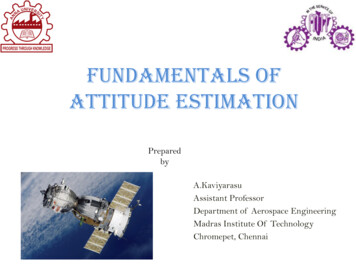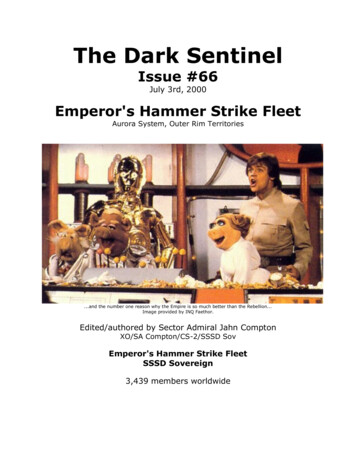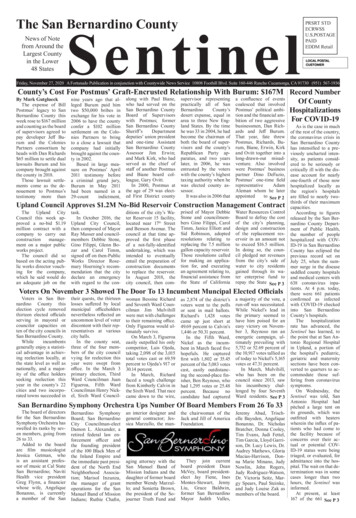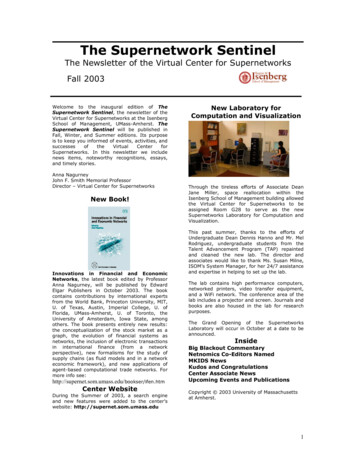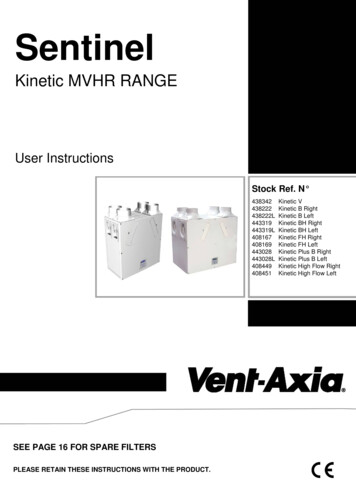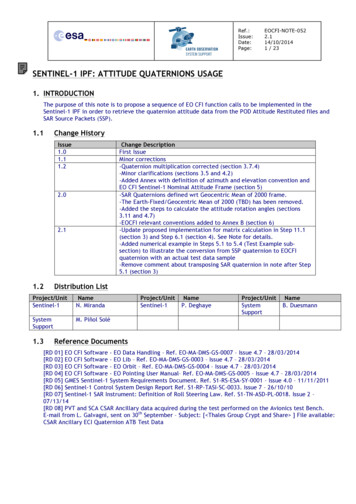
Transcription
Ref.:Issue:Date:Page:EOCFI-NOTE-0522.114/10/20141 / 23SENTINEL-1 IPF: ATTITUDE QUATERNIONS USAGE1. INTRODUCTIONThe purpose of this note is to propose a sequence of EO CFI function calls to be implemented in theSentinel-1 IPF in order to retrieve the quaternion attitude data from the POD Attitude Restituted files andSAR Source Packets (SSP).1.1Change HistoryIssue1.01.11.2Change DescriptionFirst IssueMinor corrections-Quaternion multiplication corrected (section 3.7.4)-Minor clarifications (sections 3.5 and 4.2)-Added Annex with definition of azimuth and elevation convention andEO CFI Sentinel-1 Nominal Attitude Frame (section 5)-SAR Quaternions defined wrt Geocentric Mean of 2000 frame.-The Earth-Fixed/Geocentric Mean of 2000 (TBD) has been removed.-Added the steps to calculate the attitude rotation angles (sections3.11 and 4.7)-EOCFI relevant conventions added to Annex B (section 6)-Update proposed implementation for matrix calculation in Step 11.1(section 3) and Step 6.1 (section 4). See Note for details.-Added numerical example in Steps 5.1 to 5.4 (Test Example subsection) to illustrate the conversion from SSP quaternion to EOCFIquaternion with an actual test data sample-Remove comment about transposing SAR quaternion in note after Step5.1 (section 3)2.02.11.2Distribution ListProject/UnitSentinel-1NameN. MirandaSystemSupportM. Piñol Solé1.3Project/UnitSentinel-1NameP. DeghayeProject/UnitSystemSupportNameB. DuesmannReference Documents[RD 01] EO CFI Software - EO Data Handling – Ref. EO-MA-DMS-GS-0007 – Issue 4.7 – 28/03/2014[RD 02] EO CFI Software - EO Lib – Ref. EO-MA-DMS-GS-0003 – Issue 4.7 – 28/03/2014[RD 03] EO CFI Software - EO Orbit – Ref. EO-MA-DMS-GS-0004 – Issue 4.7 – 28/03/2014[RD 04] EO CFI Software - EO Pointing User Manual– Ref. EO-MA-DMS-GS-0005 – Issue 4.7 – 28/03/2014[RD 05] GMES Sentinel-1 System Requirements Document. Ref. S1-RS-ESA-SY-0001 – Issue 4.0 – 11/11/2011[RD 06] Sentinel-1 Control System Design Report Ref. S1-RP-TASI-SC-0033. Issue 7 – 26/10/10[RD 07] Sentinel-1 SAR Instrument: Definition of Roll Steering Law. Ref. S1-TN-ASD-PL-0018. Issue 2 –07/13/14[RD 08] PVT and SCA CSAR Ancillary data acquired during the test performed on the Avionics test Bench.E-mail from L. Galvagni, sent on 30th September – Subject: [ Thales Group Crypt and Share ] File available:CSAR Ancillary ECI Quaternion ATB Test Data
Ref.:Issue:Date:Page:EOCFI-NOTE-0522.114/10/20142 / 232. ASSUMPTIONSThe following assumptions have been considered: Both the POD Restituted Orbit files and the internal orbit files generated from the SAR SourcePackets are assumed to be compliant with the EO CFI restituted orbit file format (see [RD 01]) Both the POD Restituted Attitude files and the internal attitude files generated from the SAR SourcePackets are assumed to be compliant with the EO CFI attitude file format (see [RD 01]) The attitude quaternions in the attitude files represent the rotation from Geocentric Mean of 2000(if internal attitude files) or Earth-Fixed (if POD Restituted Attitude files) to Satellite AttitudeFrame. The POD Restituted attitude files follow the quaternion and axes convention used by EO CFI (seeAnnex B).3. DATA FROM SAR SOURCE PACKETS: OUTLINE OF THE CALLING SEQUENCE3.1Step 1Read orbit state vectors (PVT) and attitude quaternions (QT) from the SAR Source Packets. The PVT and theQT may have different time stamps. satellite position and velocity vectors in Earth-Fixed Coordinate System at a given time t i : rEF , vEF quaternion from Geocentric Mean of 2000 Frame to Satellite Attitude Frame at a timetj :QGM 2000 SAT ATTIn order to cope with the different time stamps, the PVT data has to be read and written to an internal EOCFI orbit file and the QT data has to be read and written (after transformation) to internal EO CFI attitudefile.3.2Step 2Obtain time correlation information (for example, from IERS Bulletin A or B). This time correlationinformation (UTC-TAI, UTC-UT1) will be used to write the internal EO CFI orbit file, together with theposition and velocity vectors in Earth-Fixed CS.3.3Step 3Write the time t i and satellite position and velocity rEF , vEF to internal EO CFI orbit file.EO CFI hint: Call function xd write orbit file ([RD 01])3.4Step 4Initialize the model id. Initialize the time id using internal EO CFI orbit file, IERS Bulletin A or B and theorbit id using the internal EO CFI orbit file.EO CFI hint: Call functions xl model init (mode default), xl time ref init file (mode AUTO) andxo orbit init file (mode AUTO). See [RD 02] and [RD 03].3.5Step 5Convert the quaternion from Geocentric Mean of 2000 Frame to Satellite Attitude Frame to a quaternionfrom Geocentric Mean of 2000 Frame to EO CFI Satellite Attitude Frame.Details provided in steps 5.1 to 5.4 below.3.5.1 Step 5.1Re-arrange the elements of the input quaternion such thatpart, see section 6.6 b).q3 is the real part and ( q0 , q1, q2 ) the vector
Ref.:Issue:Date:Page:EOCFI-NOTE-0522.114/10/20143 / 23q0 EOCFI q1q11EOCFI q2q2EOCFI q3q3EOCFI q0Note: It is assumed that the quaternion in the SAR Source Packet represents the transformation fromGeocentric Mean of 2000 to Satellite Attitude Frame, so the corresponding matrix would transform avector in Geocentric Mean of 2000 into a vector in Satellite Attitude Frame (see Section 6).3.5.1.1Proposed Implementation/* STEP 5.1: re-assign, q0 real -- q[3] in EO CFI convention*/q[0] q1;q[1] q2;q[2] q3;q[3] q0;3.5.1.2Test ExampleA quaternion sample has been extracted from SCA CSAR Ancillary data acquired during the test performed on theAvionics test Bench (see [RD 08]):/*q0q1q2q3Quaternion -- q0 scalar part */ -0.3229468762874603272; -0.9336623549461364746; 0.02849436365067958832; -0.1522108763456344604;Output of Step 5.1 (re-assign quaternion components):q0q1q2q3 522108763456344604;-0.3229468762874603272;3.5.2 Step 5.2Transform the quaternion obtained after Step 5.1 to a matrix.Since the SAR Source Packet quaternion represents the transformation from Geocentric Mean of 2000 toSatellite Attitude Frame, then the matrix obtained would represent the rotation M GM 2000 SATATT , whichtransforms a vector in Geocentric Mean of 2000 into a vector in Satellite Attitude FrameEO CFI hint: Call function xl quaternions to vectors (see [RD 02]) and assign the output vectors of thefunction to the columns of a matrix:Q [ q0q1 q2 u1 u1 u1yz xq3 ] M u x2 u y2 uz2 u x3 u y3 uz3
/20144 / 23Proposed Implementation/* STEP 5.2: Transform to matrix */status xl quaternions to vectors(q, ux vec, uy vec, uz vec, xl ierr);if (status ! XL OK){func id XL QUATERNIONS TO VEC ID;xl get msg(&func id, xl ierr, &n, msg);xl print msg(&n, msg);if (status XL ERR) return(XL ERR);}/* Assign to matrix */for(i 0;i 3;i ){matrix aux[i][0] ux vec[i];matrix aux[i][1] uy vec[i];matrix aux[i][2] uz vec[i];}3.5.2.2Test ExampleOutput of Step 5.2 (convert quaternion to matrix):0.952039848 0.045103818 0.302631414-0.151520260 -0.789786806 0.5943722840.265822757 -0.611720890 -0.7450743693.5.3 Step 5.3Re-assign the rows of the resulting attitude matrix, to map the axes convention from Satellite AttitudeFrame to EO CFI Satellite Attitude Frame (see Section 6.6. a))According to Section 6.2: GM 2000 GM 2000PSATATT GM 2000 [ X SATATTYSATATT GM 2000]Z SATATTwhere GM 2000 X SATATTis the unitary direction vector along X-axis of Frame Satellite Attitude Frame (expressed inGeocentric Mean of 2000) GM 2000is the unitary direction vector along Y-axis of Frame Satellite Attitude Frame (expressed in YSATATTGeocentric Mean of 2000) GM 2000is the unitary direction vector along Z-axis of Frame Satellite Attitude Frame (expressed in Z SATATTGeocentric Mean of 2000)Then the rotation matrix from Step 7.2 would correspond to the transposed matrix:M GM 2000 SATATT X SATATT YSATATT Z SATATT Using the relation between the axes definition of the Satellite Attitude Frame in [RD 06] and the EO CFISatellite Attitude Frame (established in Section 6.6 a)):
Ref.:Issue:Date:Page:EOCFI-NOTE-0522.114/10/20145 / 23 EOCFI X SATATT Y SATATT EOCFI YSATATT X SATATT EOCFI Z SATATT Z SATATTThen to be compliant with the EO CFI Satellite Attitude Frame definition we just need to re-assign therows of the resulting attitude matrix from Step 5.2:M GM 2000 SATATT3.5.3.1 X SATATT YSATATT Z SATATT Y EOCFI SATATTEOCFI N GM 2000 EOCFI SATATT X SATATT EOCFI Z SATATT Proposed Implementation/* STEP 5.3: Re-assign rows to go from Sentinel-1 Attitude frame axes convention to EOCFI Satellite Attitude Frame definition */for (i 0;i 3;i ){matrix aux2[0][i] -matrix aux[1][i];matrix aux2[1][i] -matrix aux[0][i];matrix aux2[2][i] -matrix aux[2][i];}3.5.3.2Test ExampleOutput of Step 5.3 (re-assign rows to map S1 to EO CFI satellite attitude frame axes):0.151520260 0.789786806 -0.594372284-0.952039848 -0.045103818 -0.302631414-0.265822757 0.611720890 0.7450743693.5.4 Step 5.4Calculate the quaternion corresponding to the transformation matrix from Geocentric Mean of 2000 toEO CFI Satellite Attitude Frame N GM 2000 EOCFI SAT ATT (from Step 5.3)EO CFI hint: Call function xl vectors to quaternions (see [RD 02]) assigning the columns of the matrix tothe input vectors u x ,u y ,u z :N GM 2000 EOCFI SATATT u1 u1 u1yz x222 u x u y uz u x3 u y3 uz3 The quaternion will be: S s0EOCFI 3.5.4.1 s1EOCFIs2EOCFIEOCFIthe real part.s3EOCFI with s3 Proposed Implementation/* STEP 5.4: Assign matrix to vectors and calculate the EO CFI quaternion */for(i 0;i 3;i ){ux vec[i] matrix aux2[i][0];
Ref.:Issue:Date:Page:EOCFI-NOTE-0522.114/10/20146 / 23uy vec[i] matrix aux2[i][1];uz vec[i] matrix aux2[i][2];}status xl vectors to quaternions(ux vec, uy vec, uz vec, q cfi, xl ierr);if (status ! XL OK){func id XL VEC TO QUATERNIONS ID;xl get msg(&func id, xl ierr, &n, msg);xl print msg(&n, msg);if (status XL ERR) return(XL ERR);}3.5.4.2Test ExampleOutput of Step 5.4 (convert matrix to quaternion):q0q1q2q33.6 0347486678;Step 6Write timet j and quaternion data S s0EOCFI s1EOCFIs2EOCFIs3EOCFI to internal EO CFI attitude quaternion file.EO CFI hint: Create fixed header structure. Call function xd write att (see [RD 01]).3.7Step 7Initialize the Satellite Nominal Attitude with the EO CFI Zero-Doppler Attitude Frame.EO CFI hint: Call xp sat nominal att init model with mode SENTINEL-1 and setting the roll steeringparameters to zero (so only the Zero-Doppler attitude is applied as nominal law, see Section 5.1.1):model param[0] 0.0060611;model param[1] -0.729211585E-4;model param[2] 0.0;model param[3] 0.0;model param[4] 0.0;model param[5] 0.0;model param[6] 0.0;model param[7] 0.0;model param[8] 0.0;model param[9] 0.0;model param[10] 0.0;model param[11] 0.0;model param[12] 0.0;model param[13] 0.0;See [RD 04].3.8Step 8Initialize the Satellite Attitude using the EO CFI attitude quaternion file.EO CFI hint: Call function xp sat att init file (see [RD 04]).
47 / 23Step 9 (optional)If the instrument is misaligned wrt Satellite Attitude Frame, initialize the Instrument Attitude using the EOCFI instrument frame initialization function.EO CFI hint: For example, call function xp instr att angle init or xp instr att matrix init (see [RD 04]).3.10 Step 10Compute the satellite position and velocity vectors in Earth-Fixed at a given timevectors will be used in Step 11.EO CFI hint: Call function xo osv compute (see [RD 03])t . The output state3.11 Step 11Calculate the attitude rotation angles between EOCFI Satellite Nominal Frame (set to EO CFI Zero-DopplerAttitude Frame, see Step 7) and EOCFI Satellite Attitude Frame (i.e. Roll Steering Law angles).Details provided in steps 11.1 to 11.2 below.3.11.1Step 11.1Compute the transformation matrixPZDOP EOCFI SATATT that transforms a vector in EO CFI Zero-DopplerAttitude Frame ( EO CFI Satellite Nominal Attitude Frame) into a vector in Satellite Attitude Frame fortime t : u EOCFI SATATT PZDOP EOCFI SATATT u ZDOPThen, according to Section 6.2,PZDOP EOCFI SATATTwith x1 x2 x 3y1y2y3z1 z2 z3 X ( x1 , x2 , x3 ) the unitary direction vector along the X-axis of the EO CFI Zero-Doppler Attitude Frame(expressed in EO CFI Satellite Attitude Frame)Y ( y1 , y2 , y3 ) the unitary direction vector along the Y-axis of the EO CFI Zero-Doppler Attitude Frameexpressed in EO CFI Satellite Attitude Frame)Z ( z1 , z2 , z3 ) the unitary direction vector along the Z-axis of the EO CFI Zero-Doppler Attitude Frame(expressed in EO CFI Satellite Nominal Frame)EO CFI hint: Call function xp change frame three times (in mode direction, input frame set to SatelliteNominal Attitude, output frame set to Satellite Attitude Frame) with input unitary direction vectors(1, 0, 0 ) , ( 0,1, 0 ) and ( 0, 0,1) . The output vectors correspond to the columns of the transformationmatrix from Satellite Nominal Attitude Frame to Satellite Attitude Frame. The satellite position andvelocity vectors at time t will be used as input. See [RD 04].Note: In order to circumvent an anomaly in EO CFI v4.7, the implementation proposed below makes useof an intermediate frame (e.g. Geocentric Mean of 2000) to obtain two matrices and build thetransformation matrix from Satellite Nominal Attitude Frame to Satellite Attitude Frame with theproduct matrix as follows: CZDOP EOCFI SATATT AGM 200 EOCFI SATATT BZDOP GM 20003.11.1.1Proposed Implementation/* STEP 11.1a: Calculate rotation matrix between Geocentric Mean of 2000 Frame andSatellite Attitude Frame (initialized from internal attitude file) */mode XP MODE FLAG DIRECTION;deriv XP NO DER;
Ref.:Issue:Date:Page:frame flag inputframe id inputframe flag outputframe id outpu
2.1 -Update proposed implementation for matrix calculation in Step 11.1 (section 3) and Step 6.1 (section 4). See Note for details. -Added numerical example in Steps 5.1 to 5.4 (Test Example sub-section) to illustrate the conversion from SSP quaternion to EOCFI quaternion with an actual test data sample -Remove comment about transposing SAR quaternion in note after Step 5.1 (section 3) 1.2 .


